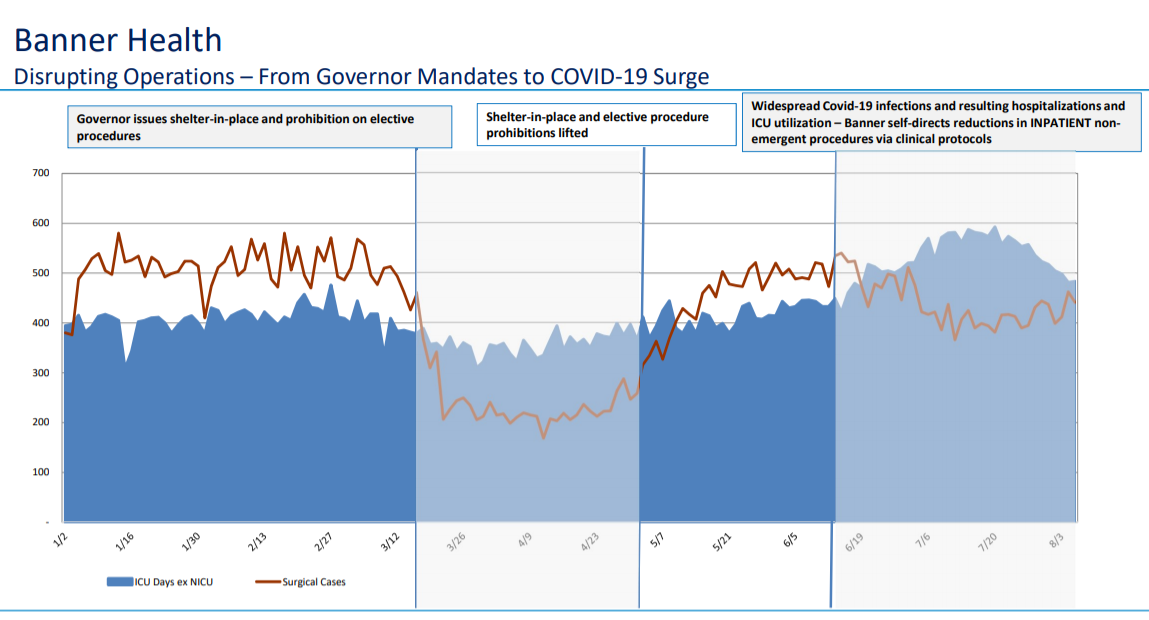Dive Brief:
- Banner Health weathered a turbulent first six months of the year as the novel coronavirus first tore through the east coast and later Arizona, where the nonprofit is the state’s largest provider. Banner’s expenses outpaced revenue during the first half of the year as it generated revenue of $ 4.76 billion, an increase of 1.8%, while expenses rose 1.9% to $ 4.65 billion.
- Given the challenging conditions, operating income fell 2.5% to $ 109 million compared to the prior-year period, according to financial filings posted Thursday.
- Largely due to investment losses, Banner posted an overall net loss of $ 267.2 million for the first half of the year, compared to net income of about $ 431 million for the first half of 2019.
Dive Insight:
Banner, like most other health systems, faced significant volume losses this spring that started to recover in May as stay-at-home orders were lifted. But then a surge of COVID-19 cases hit Arizona, where the majority of Banner’s hospitals are located.
Executives said the system bore the brunt of Arizona’s COVID-19 crises, caring for about half of the state’s hospitalized cases at the peak in mid-July.
Despite the flood of patients to Banner’s facilities, executives tried to reassure investors on a call Thursday that the system is capable of caring for both COVID-19 patients and elective care.
Executives suggested the system can monitor and adjust elective procedure volumes without having to totally stop or shutdown the lucrative business.
“Punch line here is that healthcare systems and management can manage through the crisis between COVID and non-COVID populations better than state agencies and government orders can do for our healthcare system,” CFO Dennis Laraway said.
To illustrate, surgeries declined dramatically during the mandated shelter-in-place orders that prohibited certain procedures during a five-week window through late March and all of April.
However, those declines were less dramatic toward the end of June when the system implemented its own reductions in surgical procedures even amid widespread infection and hospitalization.

Laraway credited federal financial relief funds for helping keep the system whole.
“Surgery volumes declined dramatically, and that’s the business and revenue loss that much of the stimulus dollars are supporting today,” Laraway said.
Banner received $ 210 million in grants from the Coronavirus Aid, Relief and Economic Security Act that was recorded in revenue for the first six months of 2020.
It also got $ 609 million in advanced Medicare payments from CMS that it has to pay back.
Despite the headwinds posed by the pandemic, the system currently has 256 days cash on hand.
And ratings agency Fitch has noted that Banner’s size and breadth of business should enable it to manage through the volatility.
The ratings agency reaffirmed the system’s rating and stable outlook in April, “driven by the system’s strong financial profile assessment, increasingly successful integration of their Tucson market (and Banner’s entirely related University initiatives), strength of Banner’s core hospital delivery system and growing financial stability in Banner’s insurance division.”
Banner’s insurance arm has seen increasing membership in its health plans, including its commercial plan with Aetna. It’s rolling out its own Medicare Advantage plan this fall with coverage beginning at the first of next year.
